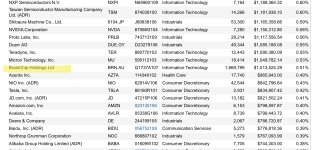I tried to make the point on the weekend that Brainchip's house has many rooms prepared and in one of those already occupied rooms is Renesas. In another is ARM. (Important to remember as you read the article below.) Renesas is one of those unromantic companies that most Australians and even Americans would not recognise by name even though they have a huge reach around the world and are the world wide number one supplier of MCU's. As part of my effort to evangelise to all new shareholders and even the not so new that Brainchip a bit like Renesas has according to the author of the following document quietly and effectively been building a world class ecosystem of partners and customers just as Renesas has over many decades. Take the time to read the following you will be impressed with Brainchips involvement with Renesas:
CLOUD
Renesas Rising Beyond Automotive Into IoT And Infrastructure
Patrick Moorhead
Senior Contributor
I write about disruptive companies, technologies and usage models.
New! Follow this author to stay notified about their latest stories. Got it!
Follow
Feb 25, 2022,02:20pm EST
Listen to article12 minutes
https://policies.google.com/privacy
In the world of tech, success takes many forms. Some "it" companies blow up overnight. A lucky few of them manage to parlay the hype into long-term success, eventually finding their sea legs. I've got a particular appreciation for the slower-burn companies, the unsung heroes who toil behind the scenes, amassing impressive portfolios of IP over the years that you've probably used before without realizing.
One such company, in my mind, is Renesas Electronics Corporation, headquartered in Tokyo. Founded in 2002 (with operations beginning in 2010). Renesas is the #1 MCU supplier in the world and well known for its automotive capabilities over many decades.
Now, under Representative Director, President and CEO Shibata-san’s leadership, under the mission of “Making People’s Lives easier,” he has expanded scope into the IoT, industrial and infrastructure markets. I think the unsung piece of the Renesas story is the IIBU (IoT and Infrastructure Business Unit). When you combine next-generation cars to the booming industrial IoT space to smart cities and infrastructure, intelligent endpoints have never been a hotter commodity than the present moment. And quite the investment opportunity.
I’d like to spend some time talking about the IIBU.
Technology trends driving growth opportunities
Last month I listened in on a talk delivered by Sailesh Chittipeddi, Executive VP and GM of Renesas' IoT and Infrastructure Business Unit, concerning the company's growth in IIoT. Chittipeddi led off by citing a few notable trends aiding growth: migration to the smart factory, a growing emphasis on sustainability, a shift from ASICs towards more standard products and the popularization of brushless DC motors.
IIOT and Industrial Growth A Snapshot 2020 - 2021
RENESAS
MORE FROMFORBES ADVISOR
By
Amy Danise
Editor
By
Amy Danise
Editor
Above, you can see Renesas's projected growth in IoT (30% CAGR), Infrastructure (18% CAGR) and Industrial (15% CAGR) segments for the 2020-2021 period. Chittipeddi warned against attributing Renesas's IoT and Industrial growth to a "rising tides raise all ships" scenario. He pointed out that Renesas doesn't operate as a broad-based point product provider, unlike some competitors. Instead, Renesas targets several specific market areas with its industrial automation and motor control offerings.
In the realm of infrastructure, Renesas's growth is coming predominately from datacenter-focused infrastructure power, timing and memory interfaces. In IoT, the company's core microcontroller business is doing the heavy lifting. In the industrial sector, the ASIC and MPU businesses are driving growth. Overall, Renesas's Industrial Automation segment grew approximately 20% from 2020 to 2021, while its Motor Control segment grew by 30% over the same period. As this growth likely connects to the broader digital transformation and modernization trend across industries, I don't expect to see it slow down any time soon. The widespread adoption of 5G, Wi-Fi 6 and 6e connectivity standards should only accelerate these trends further.
Growth and profit in the industrial sector
Looking at the financials for Renesas's industrial segment since 2019 (see slide below), we can see several positive trends worth noting. Revenue in the industrial segment has grown at a 23% CAGR, gross profits have grown at a 31% CAGR and the segment's operating income has shot through the roof at a CAGR of 62%.
IIOT and Industrial Financial Trends At a Glance
RENESAS
Renesas already has an impressive global customer base in industrial automation. This includes companies such as Rockwell Automation and Emerson in the Americas, Siemens, Hilscher and Schneider Electric in Europe, Inovance and Delta in the Asia-Pacific region and heavy hitters Mitsubishi Electric, Fanuc and Yaskawa in Japan.
With these and many other customers under its belt, Renesas touts itself as a leading semiconductor supplier for "Industry 4.0." In this vision for the future, highly integrated smart factories dominate the industrial landscape, promising to significantly enhance productivity, efficiency, and safety by implementing advanced automation, control, monitoring, and analysis capabilities.
Industrial Automation Pyramid
RENESAS
Industrial automation
Renesas illustrates its place in the world of industrial automation with a helpful pyramid graphic (see above). At the bottom, the Access Layer consists of the various technology that operates on the factory floor. Here, intelligent sensors and actuators connected through a local field network gather data and send it up the stack for control, monitoring and analysis. The second layer, the Control Layer, includes the system or industrial network and its processes—namely, automation, monitoring and control. Lastly, the Analysis Layer at the top of the pyramid is where most computing and data analysis occurs. Current technological limitations relegate most of this work to the cloud.
As you can see, Renesas's portfolio of digital, analog, timing and standard products are well-represented in the industrial automation pyramid. Renesas offers MPUs, MCUs, PMICs, ASICs, and timing solutions for the Control Layer. In the Access Layer, Renesas provides Smart SSCs, MCUs and sensors for air quality, humidity, position and flow, and interface solutions such as ASICs with IO-link and ASi.
The company's comprehensive portfolio, in my opinion, makes it uniquely positioned to deliver the levels of integration necessary to make "Industry 4.0" a reality. The company's preexisting relationships with big-name customers should also help with integration. Lastly, it's worth mentioning several recent Renesas acquisitions that have augmented the company's value proposition even further.
Dialog Semiconductor, purchased last August, gave Renesas crucial battery management capabilities, Bluetooth low-energy, Wi-Fi, Flash memory and Configurable mixed-signal custom integrated circuits (ICs). This technology, according to Renesas, should help it improve the power efficiency, charge times, performance and productivity of its offerings.
Last October, Renesas also bought
Celeno, a company specializing in connectivity solutions. Celeno's Wi-Fi 6 and 6e technology promises to benefit Renesas's industrial automation portfolio by providing higher network capacity, improved signal reliability, lower latency and the ability to mitigate crowded networks.
Our Som Growth
RENESAS
I believe all of this translates to a compelling growth story. In the figure above, you can see that Renesas anticipates its SOM (serviceable obtainable market) in industrial automation will outpace the growth of the segment's overall SAM (serviceable addressable market). In other words, not only is the market for industrial automation growing at an impressive rate (11% CAGR), but Renesas's market share is simultaneously growing within it and growing more quickly at that. Whereas Renesas claimed 8% of the overall industrial automation market in 2020, it projects it will secure 9% by 2025.
Motor control
This brings us to motor controls, Renesas's second area of focus in IoT and IIoT. Typically, a motor system consists of gears, a motor and an encoder. Of the different motor types, some examples include BLDC motors (for air conditioners, refrigerators), AC servo motors (which we typically see in industrial automation environments), fan motors (for PCs, servers) and stepping motors (utilized in printers and cameras). As mentioned briefly earlier, the movement away from AC motors towards BLDCs is a trend Renesas is gainfully riding.
Renesas's preexisting customer base is also an advantage in the motor control area. It has years of engineering know-how and customer relationships with makers of power tools, electric motors and machine tools. Its motor control base includes American household brands such as Whirlpool, GE Appliances and Emerson Electric (acquired by Nidec in Japan), European companies such as Miele, Grundfos and Bosch, APAC companies like Delta, Haier (parent company to GE Appliances) and Midea, and Japanese stalwarts Daikin, Hitachi and Mitsubishi Electric. According to Chittibeddi, these key customers form "a strong base" that is the primary driver behind Renesas's innovation engine.
MCU No. 1 Share and Strength For Motor Control
RENESAS
Renesas's market leadership in motor control has historically come from its strength in MCUs, or microcontrollers, that feature Renesas's proprietary cores. However, over the last several years, Renesas launched its RA family of MCUs, which instead leverage 32-bit Arm cores. The rollout of the RA family, starting with the RA2 in 2018, has been aggressive and impressive in equal measure. Though its leading competitor in the Arm ecosystem had a lengthy head start, having launched its first Arm-based MCU in 2010, Renesas has now effectively closed the gap from both a hardware and a software standpoint. As of 2020, Renesas now has Arm-based MCUs that cover the whole range of motor control applications, from the low end (small household and kitchen appliances) to mid-range (large household appliances) to the high end (robotics and other highly advanced applications). With its upcoming RA8 MCUs, Renesas predicts it will finally overtake the competition with the most advanced Arm core on the MCU market.

MCU Product For Motor Control Applications
RENESAS
Wrapping up
Renesas has a busy 2022 on tap and I look forward to following the company more closely than I have in the past. As it currently stands, we'll be hearing more from Renesas at the Embedded World conference in Nuremberg, Germany, in June, the not-to-miss Arm Developer Summit in the Bay Area in October and the Electronica conference in Munich, Germany, in November. At these events, I'll be watching to see if the company's gains in industrial automation and motor control live up to current projections and how Renesas plans to keep the momentum going through 2022 and beyond.
Next week, I will be listening into the company’s
investor call to get the latest and greatest.
MY OPINION ONLY DO DYOR
FF
AKIDA BALLISTA











